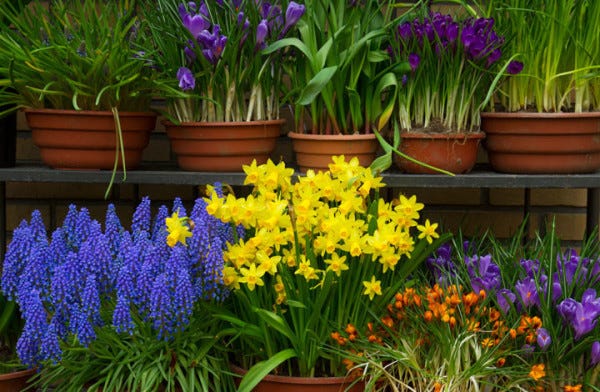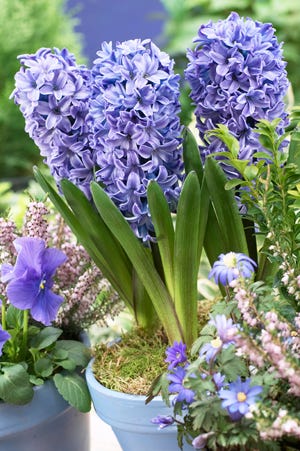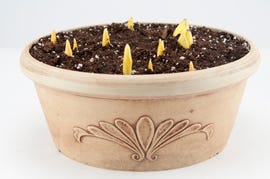Forcing Bulbs For Early Indoor Color
by High Country Gardens

Tips on Forcing Bulbs in Indoor Containers.

Aside from Poinsettias, two signature flowers, Amaryllis and Paperwhites, are favorites for the winter holiday season. These bulbs are easy to grow with spectacular results. They need no chilling, and once planted can bloom in as little as 3-5 weeks for Paperwhites, and just 6-8 weeks for Amaryllis. But once these blooms fade, many other bulbs can take their place and provide spots of indoor color just when winter winds are their coldest. Forcing bulbs to bloom early in containers indoors is not difficult. Here are some tips on selecting, planting, storing, and starting early-blooming bulbs inside your home for winter color.
Selecting Bulbs
A few of the possibilities for forcing include the following: Iris reticulata, Crocus, Hyacinth, Muscari (Grape Hyacinth), Tulips, Daffodils, and other unique fall bulbs such as Scilla and Chionodoxa.
Planting
- Use a container with a drainage hole. Simple plastic pots can be inserted in a decorative container or basket once the bulbs are ready to bloom.
- Use a container deep enough to hold a 2-inch layer of good potting soil topped with enough soil to cover the bulbs.
- Bulbs may be closely spaced, even touching on the sides.
- Fill loosely with soil allowing a little space below the rim for watering.
- Water bulbs well immediately after planting.
- Label the containers with the bulb name, date planted, and the approximate date they can come out of cold storage.
 When forcing bulbs for indoors, they need to be chilled for many weeks prior.
When forcing bulbs for indoors, they need to be chilled for many weeks prior.
Cold Storage
Bulbs need a period of dark, cold storage to simulate being in the ground. A cold frame, unheated garage, or refrigerator will work. If using a cold frame, mulch the containers so they remain in the dark. Likewise, in a garage or refrigerator, cover the pots loosely with foil so they are not exposed to light.
The temperature should remain fairly constant at about 40 to 45 degrees. They should not be allowed to freeze. Check the bulbs regularly and water when dry. Keep this period of cold storage from 10 to 16 weeks, depending on the type of bulb. Use the following chart as a guide; but the best way to determine if bulbs are ready to come out of the cold is when growth is visible on top and roots are emerging from the drainage holes.
| Flower Bulb | Number of Weeks in Cold Storage |
|---|---|
| Chionodoxa | 15 weeks |
| Crocus | 12 to 15 weeks |
| Daffodils | 15 weeks |
| Hyacinth | 11 to 14 weeks |
| Iris reticulata | 15 weeks |
| Muscari (Grape Hyacinth) | 12 to 15 weeks |
| Scilla | 12 to 15 weeks |
| Tulips | 12 to 16 weeks |
The Warm-Up Period
Once top growth is visible, it's time for the bulbs to come out of cold storage. If necessary, it's better to leave them in cold storage a few days too long rather than bring them out too early. The growth will be very pale but it will turn green after being exposed to light.
For the first week or two, bulbs should be kept at about 60 degrees in bright, indirect light. Soil should be kept evenly moist. Once the growth is about four inches high, the pots can be moved to a sunnier and warmer location. Most bulbs will start to bloom two to three weeks after they come out of cold storage.
Before the bulbs bloom, place the plastic pot in a decorative container. You can hide the top of the plastic pot with moss. Once the bulbs bloom, it's a good idea to move them to a cooler location at night to prolong the bloom period.
When the blooms fade, cut off the flower stalks but not the leaves. Apply a little fertilizer and continue watering until the foliage completely dies down. Remove the bulbs from their pots and store them in a mesh bag in a cool dry place until planting time next fall.
Forcing bulbs is an inexpensive way to have indoor blooms for a month or two. The only cost is the bulbs themselves and some inexpensive plastic pots. On a cold day in February you'll be glad you did.
Text by Mary Ann Walz
© All articles are copyrighted by High Country Gardens. Republishing an entire High Country Gardens blog post or article is prohibited without permission. Please feel free to share a short excerpt with a link back to the article on social media websites, such as Facebook and Pinterest.